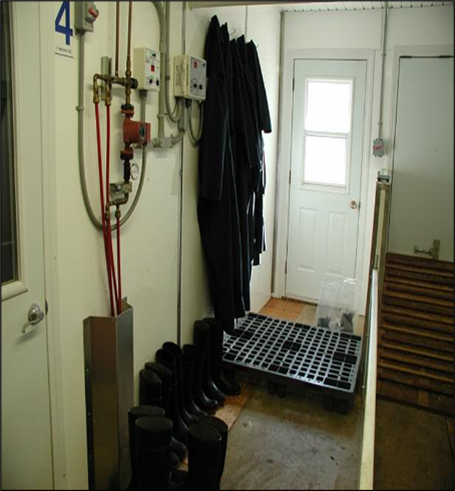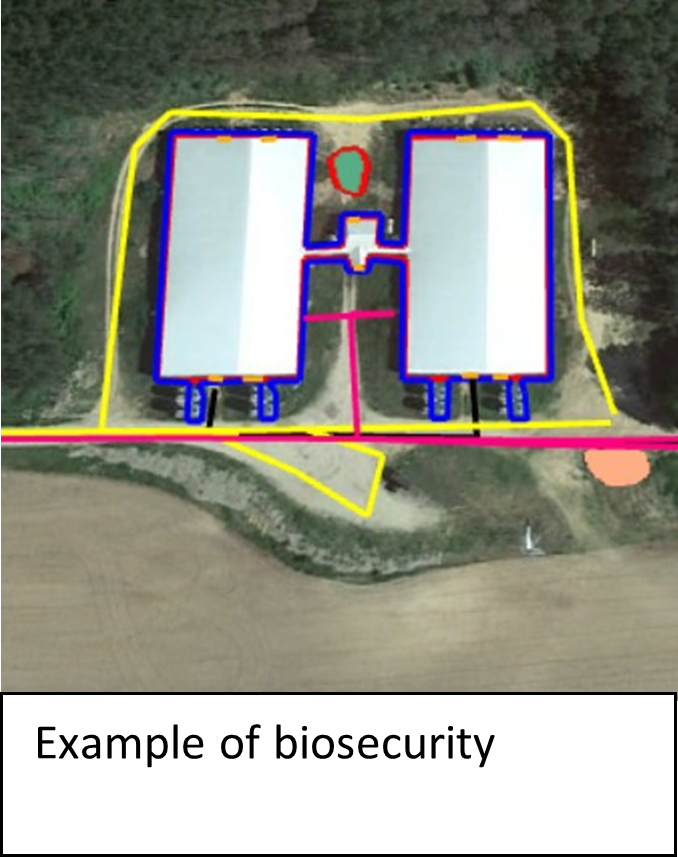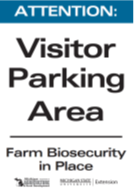Simple biosecurity tips for your small swine farm
Biosecurity tips for small pork producers.
 Effective biosecurity on a swine farm requires practices and procedures to reduce the spread of disease between pigs, people, and other swine farms. A biosecurity plan is a set of written guidelines that consistently describe how employees, service personnel, visitors, equipment, and pigs should enter your farm. This article includes guidelines on simple methods to prevent disease, biosecurity mapping including gates and signs to reduce disease through entry protocols, and comments on biosecurity planning for outdoor swine production.
Effective biosecurity on a swine farm requires practices and procedures to reduce the spread of disease between pigs, people, and other swine farms. A biosecurity plan is a set of written guidelines that consistently describe how employees, service personnel, visitors, equipment, and pigs should enter your farm. This article includes guidelines on simple methods to prevent disease, biosecurity mapping including gates and signs to reduce disease through entry protocols, and comments on biosecurity planning for outdoor swine production.
Simple methods can be applied to your daily on-farm routine to help prevent or mitigate the spread of disease on your swine farm:
- Wash hands frequently when around pigs
- Provide a sign-in log that records the last time visitors had contact with pigs
- Reduce the number of farm visitors to essential persons such as veterinarian and service personnel
- Provide designated or “farm only” clothing and boots/footwear for all visitors
- Disinfect facilities and equipment, especially between batches
- Clean equipment and vehicles prior to arrival, particularly tires and undercarriage so that bugs don’t hitch a ride onto the farm
- Implement and monitor a pest control plan
- When doing chores or checking your herd, move from the healthiest to least healthy to decrease incidence of disease spread
Additional measures:
- Move from youngest or the most vulnerable pigs first to the oldest pigs last during daily tasks
- Within age groups, work with sick or ill pigs last or after working with healthy pigs
- If a pen of pigs is sick, attend to them last and dip your boots in a disinfectant or desiccant (Mistral) as you leave that pen
- Wash your hands and when possible, change your clothes and boots
- Have downtime or days in between visiting other herds; this is dependent on the health status of the visitors’ farms or if the visitors have traveled internationally to areas known to be of high risk
- If the visitors’ farms are of high health, 24 hours and wearing designated farm clothing and boots, may be sufficient
- If the visitors are competing in a local fair, three days downtime before visiting your farm would be more practical
Visitors arriving from countries known to have disease outbreaks should have a 14-day downtime. For example, the Dominican Republic is now positive for African Swine Fever and the disease is primarily in backyard swine farms. In this situation, visitors who have recently visited the Dominican Republic should require 14 days downtime.

Along with these suggestions, having a written biosecurity plan in place and readily accessible on your farm will help you and anyone else working on your farm to help ensure a healthy herd. This plan should also include having a working relationship with your herd veterinarian or a veterinarian client patient relationship (VCPR).
Develop your plan and update it annually or when the farm production has changed. The herd veterinarian should assist in confirming on-farm diseases and illnesses, provide guidance and input on biosecurity and pig health, and help with developing a herd health plan (including a vaccination strategy) to promote a healthy herd.
Another simple way to ensure biosecurity on your farm is to create a biosecurity map. This map will take some critical thinking, but knowing your traveling routes, perimeter buffer area and lines of separation, could instruct/help identify other ways to improve your biosecurity on your property.
One way to think of a biosecurity plan is to think of your pig barns as a castle with a moat surrounding the castle and a drawbridge going up and down to allow entry of pigs, people, and equipment. The perimeter buffer area is the outer control area of your pig farm represented by the moat surrounding the castle. Each time the drawbridge goes up and down, it compromises the perimeter buffer area and is vulnerable to disease entry. Having a consistent parking area for farm employees that is separate from that for visitors will help prevent introduction of disease onto your farm. Understand the traffic patterns on and off your farm, including route(s) most used for moving pigs on/off the farm, manure hauler paths, where mortalities are sent, and on-farm routes used for other essential materials/services (i.e., propane or equipment). Knowing these patterns will help assess and improve your biosecurity boundaries. For example, try to keep feed and equipment truck paths separated in space from manure and carcass hauling paths.

The line of separation is defined as the line between where the animals are in strict control of who has access to your pigs. This usually includes the pig pen or fence line(s) or barn structure(s). Line of separation access points are the door(s) or gates(s) through which pigs, employees, and essential visitors enter and exit. Knowing who may enter the farm, via these defined “lines” or “boundaries” is essential for controlling the biosecurity and disease risk on your farm.
What about pigs raised outdoors? Swine farms that raise pigs on pasture or have partial outdoor facilities should implement as many of the procedures described above as possible. While it is more difficult to maintain a high level of biosecurity for outdoor-raised pigs, it is nevertheless possible. Having a solid and consistently applied biosecurity plan is a critical first step to raising healthy pigs outdoors. Cleaning and disinfecting vehicles (wheels and tires), equipment, and other materials that go into your PBA or animal’s facility is important. Have specific clothing and boots that are used just during chores and other animal contact activities. Being stringent on visitors and other people coming onto the farm and near your livestock will decrease the likelihood of spread disease and health concerns.
The Michigan State University Extension pork team has created the Management over Medication (MoM) Program that is aimed at increasing your knowledge related to disease prevention and thereby improving the health and safety of your swine herd. This program is targeted for small farms, but the practices included can be applied to any size operation.



 Print
Print Email
Email